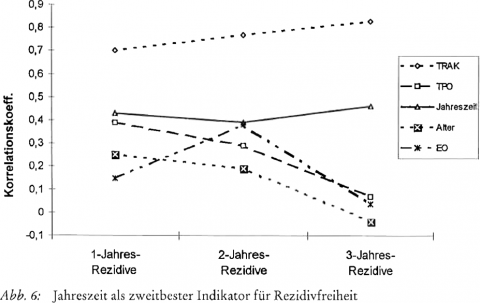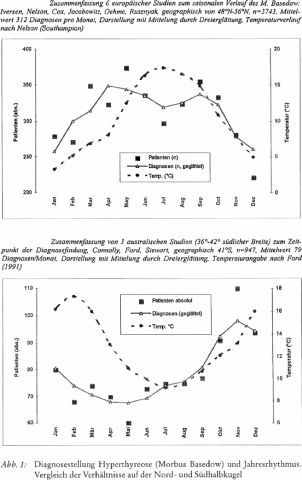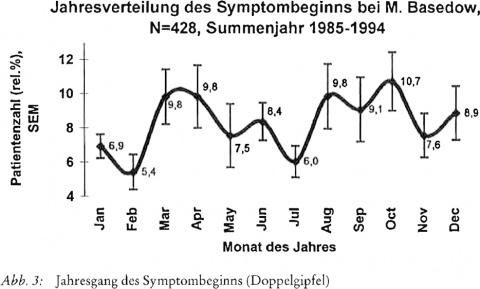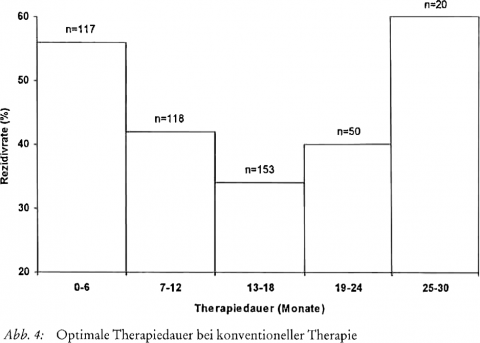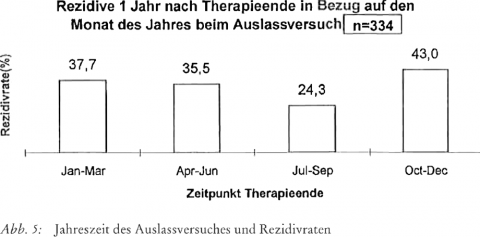Jahresrhythmus und Schilddrüsenfunktion unter besonderer Berücksichtigung des Morbus Basedow
Export Article Citation as
- Download price : €6
Abstract:
Annual rhythm and thyroid function with particular reference to Grave’s disease
Turning points in the biological year are not identical to those of the cosmic-geophysical year. The ascending half of the biological year (February to August) is marked by an ergotropic tendency for vegetatively autonomous regulation. Correspondingly, in the descending half of the year (August to February) a trophotropic condition is predominant.
The thyroid gland, an endocrine organ of great importance for heat production, shows functional and structural annual variations. Both its hormone production and volume are lower in summer than in winter.
Some aspects of autoimmune hyperthyroidism (Grave’s disease) also depend on the season. The illness is diagnosed more frequently in summer than in winter although the interval between the start of the illness (onset of symptoms) and establishing that disease is present (time of diagnosis) can on average be up to three months. This latency time, in particular, shows marked seasonal variations being appreciably shorter in summer than in winter. Taking into consideration the onset of symptoms, autoimmune hyperthyroidism shows an annual rhythm with two peaks corresponding to maxima in April and October. In the geophysical year these times are when the outside temperature is changing most rapidly.
The course of Grave’s disease hyperthyroidism occurs in waves or phases such that a phase of illness usually lasts from twelve to eighteenmonths. Regarding the matter of the danger of a rccurrence, there is evidence that a trial suspension of thyrostatic therapy is associated with a lower risk of recurrence in the summer months. The significance of possible influencing factors for a rccurrcncc (raiscd thyroid volume, raised TSH-receptor-Ab) were examined in comparison with the time of year of trial suspension of therapy. This showed that considerable significance should be attached to the annual cycle.
Therefore in thyroid disease there are chronophysiological, chronopathological and chronotherapeutic aspects.
References
- HECKMANN, C. (1999): Befunde zur Normalisierung im Rahmen der therapicbcglcitenden Forschung. Beitrag Öschelbronn 1999, Jahrestreffen der Arbeitsgemeinschaft Rhythmusforschung
- HILDEBRANDT, G. (1962): Biologische Rhythmen und ihre Bedeutung für die Bäderund Klimaheilkunde. In: Amelung, W. &; Evers, A. (Hrsg.), Handbuch der Bäder- und Klimaheilkunde, S. 730 - 785. Sehattauer Verlag, Stuttgart
- HILDEBRANDT, G. (1998): Der biologischeJahresrhythmus des Menschen. In: Tycho de Brahe-Jahrbuch für Goetheanismus 1998: 342 - 363
- TOUITOU, Y. & HAUS, E. (Eds.) (1992): Biological Rhythms in Clinical and Laboratory Medicine. Springer-Verlag Berlin, Heidelberg, New York
- NORDMANN‚ T. (1998): Circannuale Schwankungen in der Inzidenz des Morbus Basedow. Med. Inaug.-Diss. Witten/Herdecke
- WECKENMANN, M. (1970): Die Wirkung von Cardiodoron B bei Patienten mit orthostatischem Symptomkomplex. Med. Welt 21: 515 - 521
- WECKENMANN, M. (1982): Die rhythmische Ordnung von Puls und Atmung im Stehen bei orthostatisch Stabilen und Labilen. Basic Res. Cardiol. 77: 100 - 116
- WECKENMANN, M. (1999): Patienten- und Therapiebeobachtungen - Therapieprinzipien. In: Heusser, P. (Hrsg.), Akademische Forschung in der Anthroposophischen Medizin. - Beispiel Hygiogenese -, S. 149 - 183. Peter Lang-Verlag Frankfurt

